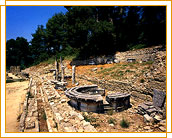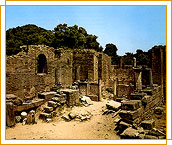Olympia during the Roman period (1st-4th century AD)
The economic and cultural development as well as the political stability during the Roman occupation imparted international character to athleticism.  When Rome granted the Roman citizenship to all the residents of the empire, Egyptians, Lykians etc, could participate and win in the Olympic Games. Extensive repairs at the temple of Zeus and other monuments took place under the auspices of the emperors. When Rome granted the Roman citizenship to all the residents of the empire, Egyptians, Lykians etc, could participate and win in the Olympic Games. Extensive repairs at the temple of Zeus and other monuments took place under the auspices of the emperors.
New dedicatory buildings and athletic facilities were built in Olympia. The Nympheum or Exedra was built by Herodes Atticus in AD 150 in honor of his wife Regilla, while at the same time it was important for the water supply of the sanctuary. The building consisted of two parts, a rectangular reservoir and behind it a semicircular one, which was surrounded by a two-storey, also semicircular, platform consisting of eleven recesses. There, statues of the Antonine family were placed, as well as of Herodes himself and his wife.
 In AD 100 new Baths were erected, to replace the old ones, while at various points of the city other baths were created. In the 3rd century AD huge earthquakes caused substantial damages to Olympia and it was necessary to carry out extensive repairs and reconstructions. The raids of barbaric tribes in 267 AD, which resulted in the devastation of many Greek cities, led to the fortification of the central section of the sanctuary using materials from the destroyed monuments of the site. In AD 100 new Baths were erected, to replace the old ones, while at various points of the city other baths were created. In the 3rd century AD huge earthquakes caused substantial damages to Olympia and it was necessary to carry out extensive repairs and reconstructions. The raids of barbaric tribes in 267 AD, which resulted in the devastation of many Greek cities, led to the fortification of the central section of the sanctuary using materials from the destroyed monuments of the site.
During the 4th century BC, great natural disasters caused the collapse of many monuments on the site. Despite this fact, the Olympic Games continued, as it is obvious from the name of the last Olympic winner, the Armenian prince Varasdates. In 393 AD, the last Olympics, the 293rd, took place.
Theodosius I forbade the organization of the Games, while after an edict of Thedosius II in 426 the Altis was torn down. Christians lived in this site until the 6th century AD and Phidias' workshop was transformed into a basilica. The new village that was built over the ancient ruins was destroyed in the end of that century, probably by the Avars. Olympia was buried under the embankments of the two rivers until the moment of its discovery by the archaeologists in the end of the 19th century.
|
